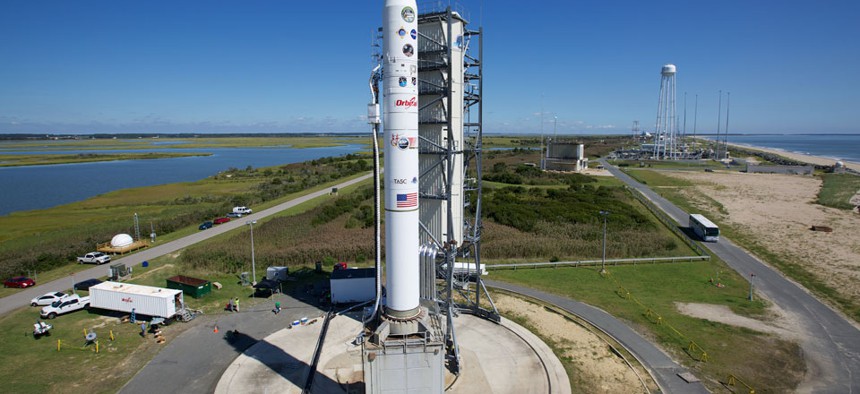Analysis: NASA’s New Role as Partner

The small car-sized Lunar Atmosphere and Dust Environment Explorer is a robotic mission that will orbit the moon. NASA
Space exploration is evolving from a government-led venture to a rich collaboration with the private sector.
Much to the chagrin of any kids who grow up idolizing astronauts, the start of the 21st century has marked an era of cutbacks for NASA. The space shuttle program shut down in 2011. A year later, Congress trimmed NASA’s overall budget appropriation by $648 million. Now that the Constellation program has lost its funding, prospects look bleak for sending astronauts back to the moon. In 1980, the United States had 100 percent of the global rocket launch capability. That share dropped to zero several years ago, but is now inching back up, thanks to private space flight.
The dismal outlook is a far cry from the heady days of the 1960s. It was then, just three years after NASA was created in 1958, that President John F. Kennedy issued his famous directive declaring that by the end of the decade the United States would send a man to the moon and bring him home safely.
NASA has radically scaled back, but space travel survives. How? In the face of fiscal constraints, the agency has changed its role. For the United States, space exploration is evolving from a government-led venture to a rich collaboration with the private sector.
As NASA has reduced its commitments, a dynamic private sector space ecosystem has sprung up vigorously into the void, and with the agency’s strong support. Richard Branson’s Virgin Galactic, for example, is developing a spacecraft to launch tourists into orbit and facilitate at least $4.5 million in NASA research contracts, prompting New Mexico to build a $209 million spaceport. Blue Origin, led by Amazon.com founder and chief executive Jeff Bezos, is developing space vehicles designed to launch and land on retractable legs. A startup called NanoRacks helps scientists who need zero-gravity environments transport their experiments to the International Space Station.
Many other companies, including Orbital Sciences, XCOR Aerospace, and Boeing, are testing vehicles for space travel. NASA is helping Moon Express Inc. develop robots to search the moon for precious metals. XCOR Aerospace is developing a two-seater Lynx vehicle to shuttle passengers to space for $95,000 a trip. Space Adventures has already sent seven people to the International Space Station from a Soviet-era launch facility in Kazakhstan.
One of the most interesting players in the new space ecosystem is SpaceX, of Hawthorne, Calif. SpaceX has more than $3 billion in contracts for more than 30 launches, including $1.6 billion from NASA. Its unmanned Dragon capsule docked on the space station in May 2012, in what was likely one of many supply runs to come.
Launched in 2002 by Elon Musk, the co-founder of PayPal and Tesla Motors, SpaceX intends to vastly reduce the cost of space ventures. “Today it costs over a billion dollars for a space shuttle flight,” Musk says. “The cost . . . is fundamentally what’s holding us back from becoming a space traveling civilization and ultimately a multiplanet species.”
Surprisingly, NASA feels no sense of rivalry with these emerging space entrepreneurs. “We have an enlightened self-interest in seeing the industry players do well,” explains Joe Parrish, NASA’s deputy chief technologist. Not only has the agency welcomed the new players in space, but it has also radically reengineered its own business model to take advantage of outside innovation. This approach sets NASA apart from most other government agencies
“Partnering with U.S. companies such as SpaceX to provide cargo and eventually crew service to the International Space Station is a cornerstone of the president’s plan for maintaining America’s leadership in space,” says John P. Holdren, assistant to the president for science and technology. “This expanded role for the private sector will free up more of NASA’s resources to do what NASA does best—tackle the most demanding technological challenges in space, including those of human space flight beyond low Earth orbit.”
NASA shows how an organization can nimbly adapt to resource constraints, offering the following lessons for agencies shifting roles within their fields:
- Instead of seeing new entrants as a threat, consider potential win-win scenarios that also yield public value.
- Support the development of platforms and exchanges that enable different providers to work together toward solving the big problems that affect everyone. You can’t begin to think about ways to combine capabilities with partners unless you know who they are and their specialties, a process that platforms can simplify.
- Get creative about the resources you can bring to the emerging ecosystem and that will provide a springboard for solutions. Perhaps it is funding, or convening a multidisciplinary team of wavemakers or something as simple as physical space for early-stage innovators to experiment side by side.
Pooling these disparate resources will reinforce that there’s more support available for problem-solving than one solitary approach. This awareness boosts not only your organization’s morale, but also the chance of reaching a solution.
--
William D. Eggers, leader of public sector research at Deloitte, and Paul Macmillan, the global public sector leader for Deloitte Touche Tohmatsu, are the authors of The Solution Revolution: How Business, Government, and Social Enterprises are Teaming up to Solve Society’s Toughest Problems (Harvard Business Press, 2013), which was released on Tuesday.


